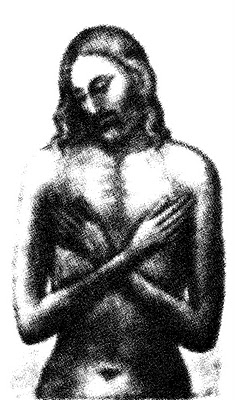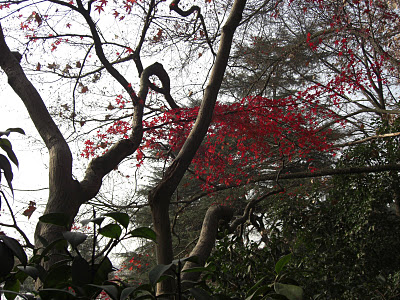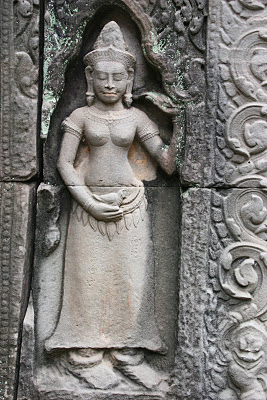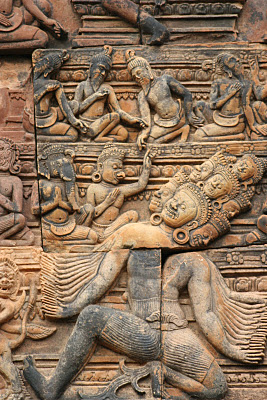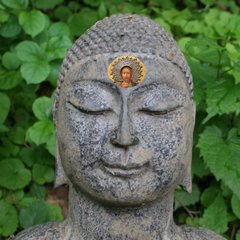
Over
the past few days, there have been several discussions about the nature
of inwardness and outwardness that provoke me to revisit this question.
Beatrice Sinclair was over for dinner on Thursday night, and she made the comment that "a princess never loses her inwardness."
Having contact with your inwardness -- your inner work -- at all times, even in ordinary life -- this is work in life.
Readers
will recall that I have mentioned we actually have two sensory systems,
each one belonging to one of our two natures. The outer sensory system,
the five ordinary senses, takes in ordinary impressions, "coarse"
impressions at a lower rate of vibration. These senses, which operate
at the speed of moving center, are only capable of just so much and no
more. When the Buddhists talk of being invested in an external life,
and attachment to the senses, and desire, they are referring to man's
habit of living through these five senses.
Hui Neng comments
thus: "People of small capacity... possess all the wisdom of prajna, the
same as people who are truly wise. So why don't they understand the
Dharma when they hear it? it's because all these beings have deluded
themselves into looking for a Buddha through external practices and
haven't yet realized their own nature that they remain people of small
capacity." (
The Platform Sutra, p. 23, translation by Red Pine, Shoemaker and Hoard, 2006.)
All
of the practices in the Gurdjieff work that seek to cultivate sensation
begin with sensation received through the outward senses. However, as
one begins to learn the meaning of sensation from inside the body, one
eventually encounters a different kind of sensation that can arise as a
motive force for Being. One begins to learn to discriminate between
inward and outward sensation, and, consequently, may begin to
see the difference between inward impressions and outward impressions.
When
we say that people lack discrimination, it is precisely in this area
that the discrimination is lacking. I would suggest, if you truly want
to try to "stay in front of your lack," that you try starting here.
People
rarely pause to consider the idea that they have a structure, an
apparatus, for the inward receiving of impressions. This structure, the
physical organs of emotional center, is built to receive impressions at
higher rates of vibration.
Indeed, the idea is very esoteric --
it is inward, inner, and one doesn't even encounter it unless one
encounters a Work. Even then, because so many works are confused and
partial, one does not necessarily encounter the idea that the structure
is quite specific and operates according to a set of laws, although
that's completely logical. After all, the structure is a machine built
within a biological organism, and every biological organism follows
natural law.
Thus, when the Buddhists say that awakening is to awaken to your own
true nature, this is literally true in a
biological
as well as an esoteric sense. On this level, it is impossible to
separate biology from consciousness. On other levels, the manifestation
of consciousness is different, and does not express itself through
DNA-based organisms. Here, it does.
That fact invokes inevitable
consequences that many works appear to wish to get rid of in one way or
another. In Gurdjieff's system, however, we see a method that begins
with and is rooted in the work of the biological organism itself for the
development of Being.
Hui Neng commented thus: "All of you
should listen carefully. Everyone's physical body is a city. Your
eyes, ears, nose, tongue, and skin are the city gates. These five gates
are all the outside, and on the inside is the gate of the intellect.
Your mind is the kingdom, and your nature is the king. When your nature
is there, so is the king... when your nature is present, your body and
mind are present. ...When the Tathagata of your enlightened natures
shines the light of wisdom on the land of your mind, the six gates shine
with purity." (
The Platform Sutra, p. 30, translation by Red Pine, Shoemaker and Hoard, 2006.)
Readers
who go to the original text will see that I have edited some, but that
is only because it is lengthy. I believe the editing still preserves
the essence of the message: There are not only five outer gates of the
five outer senses: there are also six inner gates through which
something much finer can enter us.
Because of the variety of
experience that can arise through the receiving of impressions through
any combination of the inner gates--as I call them, the six flowers--we
get a confusing array of interpretations of this inner structure. Only
Gurdjieff's Enneagram brings a sensible order to that confusing array,
because it understands the structure according to law.
Most of
the Tantric schools preserve significant fragments of this knowledge,
and of course, because everyone wants their own special river, every
school claims that it has it right.
Maybe it doesn't matter who
has it right. I think the point is that you need to discover the six
inner gates within yourself and investigate the structure. People may
disagree as to how the structure appears, what it consists of, and count
the different numbers, but
there is a structure, anyone who investigates for long enough will discover this.
Gurdjieff
brought an undeniable order and a new kind of logic to this. Other
schools get more and more confused and more and more complicated in
order to explain the nature of the inwardness from a structural point of
view; the Enneagram (which for some seems to be an extraordinarily
complex diagram) is actually quite simple and beautiful once one begins
to understand it from an inner point of view. In and of itself, it
offers a path to work which can, as Gurdjieff himself said, accelerate
the development of Being. This is why he called his work "Haida yoga,"
or, "hurry up yoga."
It's always true: when you know where you are headed, and you have a good map, you get there faster.
Getting
back to the question of the intersection between inwardness and
outwardness, once one cultivates inwardness in such a way as to bring a
wholeness to the inner structural apparatus, it operates in a
synesthetic manner, that is, it receives inner impressions in a single
whole environment that mimics the arrival of information from the
outward senses. That outward information is experienced as one single
experience, even though what takes place is divided by the five senses
into five separate sets of inputs.
That kind of inner unity within the six
inner centers can lead to a completely new set of rather magnificent experiences.
One
does not want to get too caught in this, however. The inward experience
alone is not what develops Being. That is the mistake that so many
make. Taking one last quote from our good friend Hui Neng, "...if you
practice empty-mind Zen, you will fall into a featureless void." ((
The Platform Sutra, p. 20, translation by Red Pine.)
The featureless void is beautiful. But there's no
there there.
In
this intersection between inwardness and outwardness, we discover the
two natures in intersection. Once we create something more whole within
ourselves arising from the organic sense of being, and existing within
the circulation of energy that takes place when the six inner sensory
organs are in relationship, we can retain it.
Our ultimate effort is to dwell within outward life in every circumstance, all the time,
knowing that there is not only outwardness but also inwardness. This
retention of presence within is often referred to as having a new kind
of attention. Perhaps that's dangerous. Does it need a label? That
phrase has been used so much that perhaps people don't hear it anymore.
Our understanding of it has become habitual.
We need to learn to
attend to our inwardness and bring it into life so that it meets and
blends with the outwardness of our experience. The vessel needs to be
made whole in order for that to be possible, and only the intentional
application of consciousness to the situation can seal the vessel.
Over
time, as I may have mentioned before, the taking in of inner
impressions can lead to the elimination of negativity. This is a long
process. It is, however, inevitable--because negativity cannot exist if
the structure functions properly.
And wherever and whenever inner negativity does not exist, it is replaced by something indescribable.
Much love to you all, as we gently approach this sacred moment referred to by the Christians as Christmas.
May your roots find water, and your leaves know sun.






